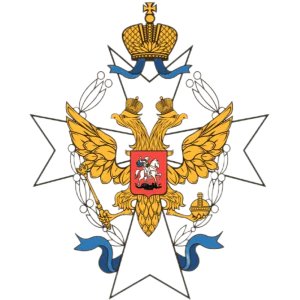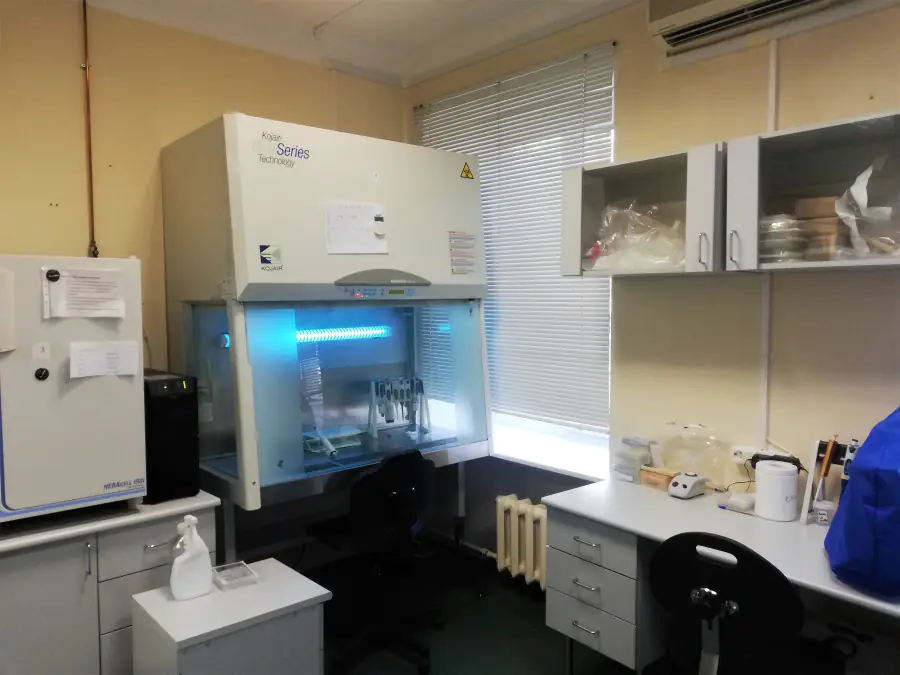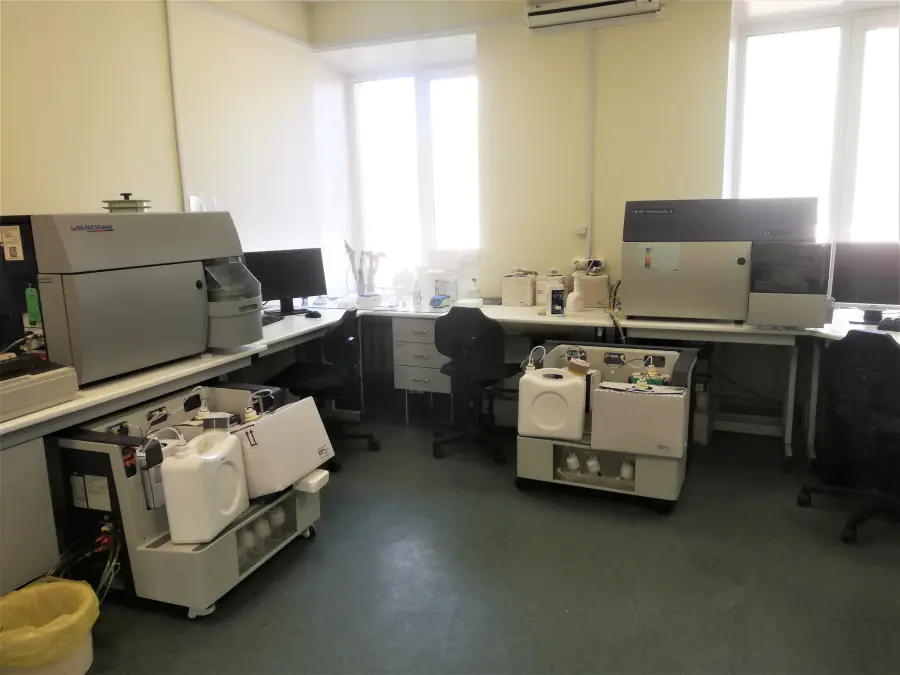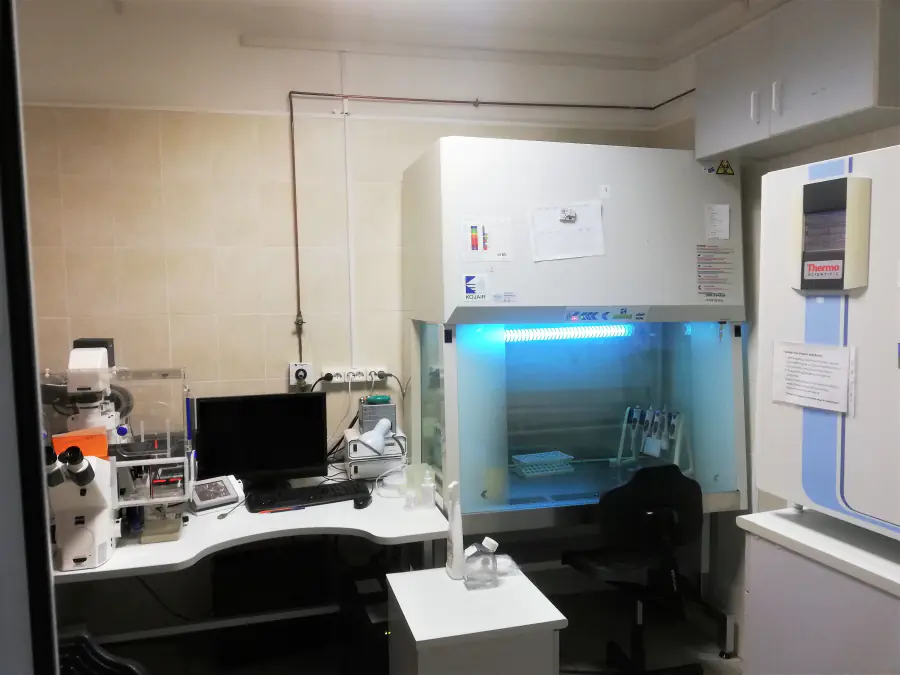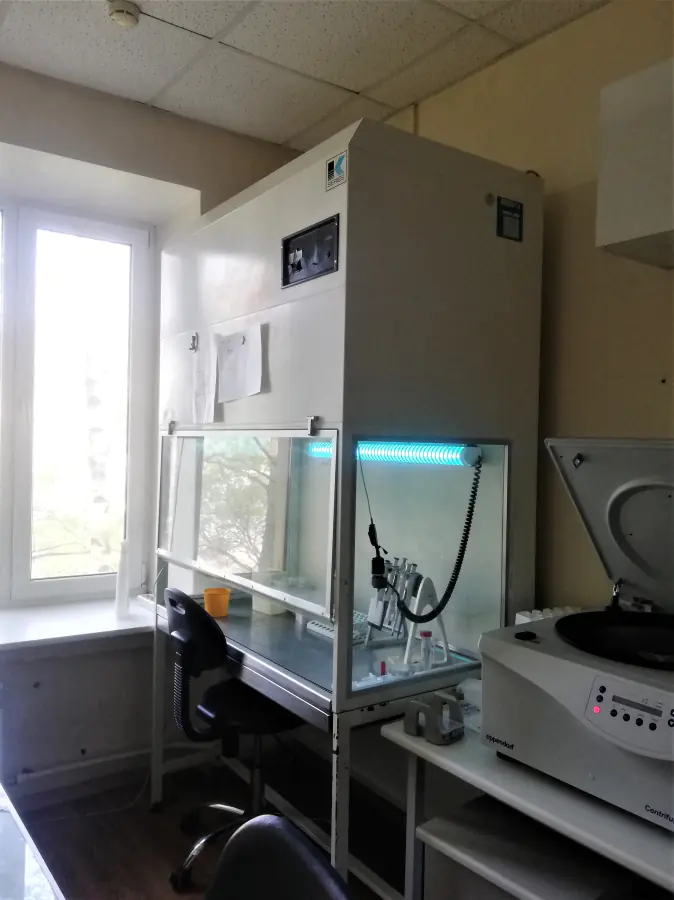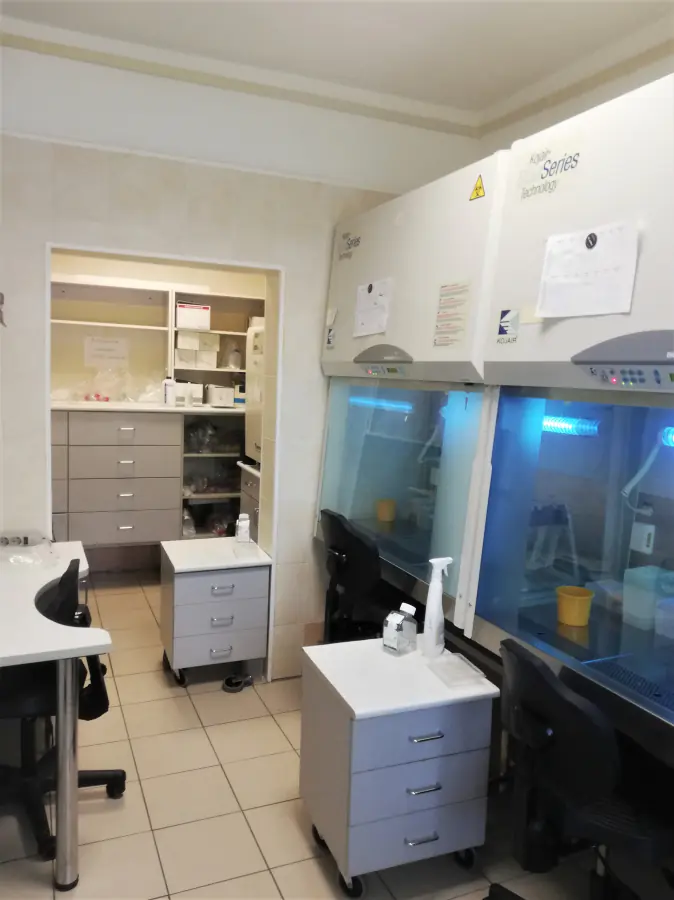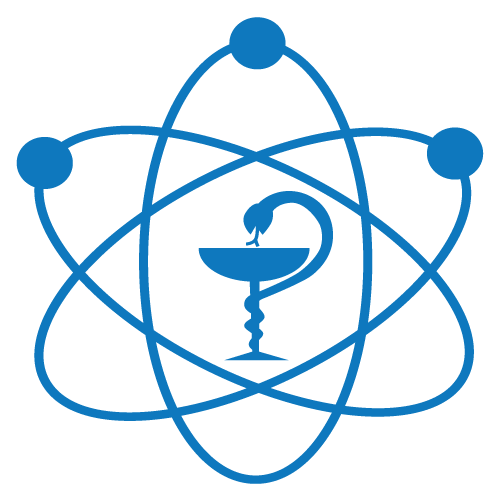Department of Immunology and Intercellular Interactions
Publications
110
Citations
611
h-index
14
Authorization required.
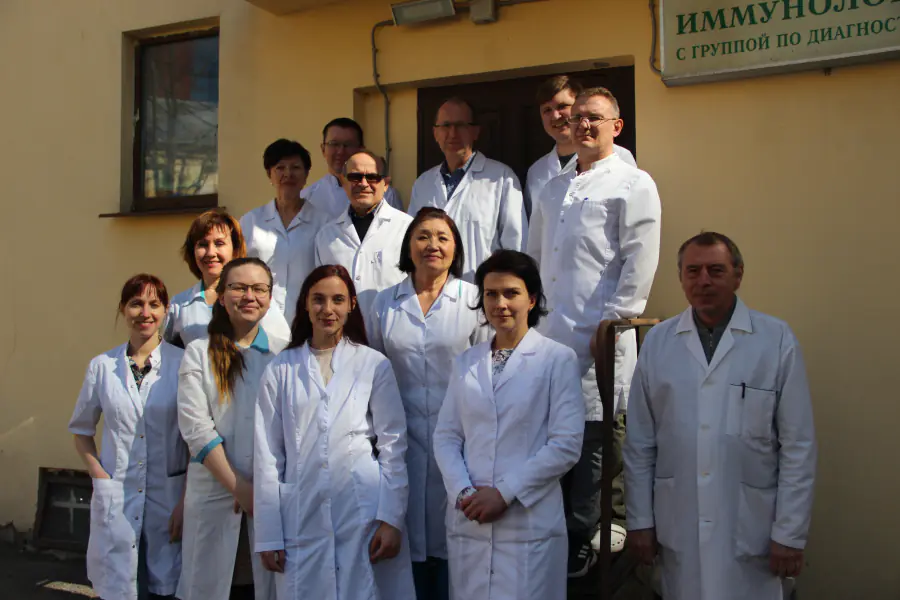
The Department of Immunology and Intercellular Interactions includes:
- Laboratory of intercellular interactions.
- The proteomic immunoregulation group.
The main areas of research:
- To study the features of the immune system during pregnancy, as well as in various forms of obstetric and gynecological pathology.
- Assessment of immune factors in various immunodeficiency conditions and recurrent infections.
- Development and appointment of immunocorrective therapy methods for various forms of obstetric and gynecological pathology, immunodeficiency conditions.
- The study of angiogenesis and the effect of cells of the immune system on this process.
- The study of the interaction of trophoblast cells and cells of the immune system.
- The study of microvesicles of cellular origin as new subjects of intercellular signaling.
- The study of the role of macrophages and natural killers in the development of the placenta.
Annually, on the basis of the department, from 5 to 8 students from various universities of St. Petersburg (St. Petersburg State University, Herzen State Pedagogical University, ITMO, Institute of Technology, Polytechnic University) They carry out research within the framework of bachelor's and master's degree programs.
According to the results of research conducted in the department, 31 candidate's and 5 doctoral dissertations have been defended since 1993.
- Flow cytometry
- Flow-through cell sorting
- Cell and tissue culture
- RT-qPCR
- Western blot
- Fluorescence microscopy
- Confocal microscopy
- Enzyme-linked immunosorbent assay (ELISA)

Oksana Marko
Junior researcher
Alina Davydova
Junior researcher
Polina Grebenkina
Junior researcher
Elizaveta Tyshchuk
Junior researcher
Maria Zementova
Research assistant
Marina Pereviazkina
Research assistant

Anastasiya Gulina
Student

Anastasia Sirotskaya
Student

Olyga Bakulina
Student
Research directions
Cell lines as materials for modeling intercellular interactions of the uteroplacental complex
+
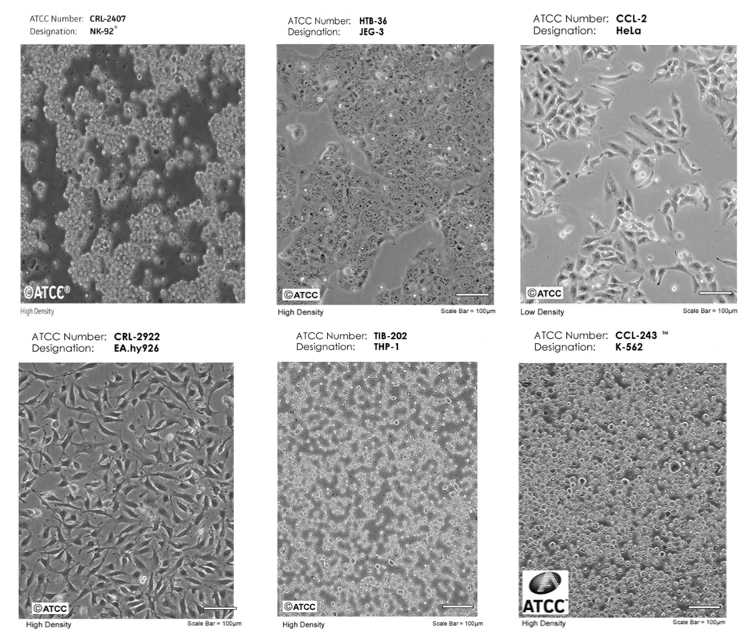
The department has the following cell lines, which are used in in vitro modeling of various intercellular interactions:
NK-92, NK-92 MI - cell lines of natural killers obtained from a patient with non-Hodgkin's lymphoma have all the main morphofunctional features characteristic of cytotoxic NK cells;
JEG-3, BeWo - human choriocarcinoma cell lines with the main morphofunctional signs of extravillous trophoblast of the first trimester of pregnancy;
Ea.Hy926 is a hybrid cell line of primary umbilical cord endothelial cells with A549 carcinoma clone, reproduces the main characteristics of endothelial cells;
THP-1 is a cell line of acute myeloid leukemia, reproduces the main characteristics of monocytes;
K562 is a cell line of chronic myelogenous leukemia, cells can develop characteristics similar to erythrocytes, granulocytes and monocytes in the early stages;
HeLa is a cell line of cervical carcinoma.
Studying the role of macrophages and natural killers in the development of the placenta
+
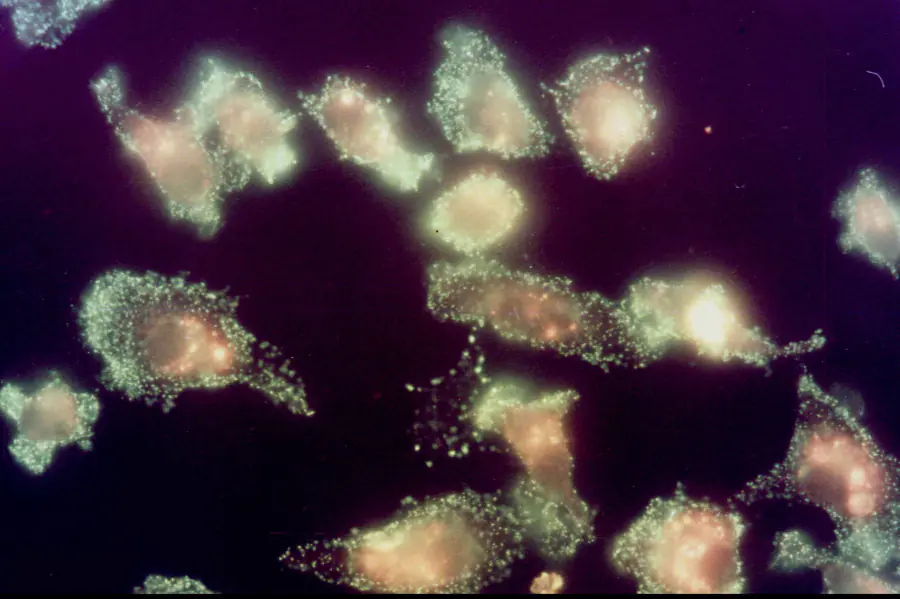
In our laboratory, it was shown that the development of the placenta is accompanied by increased signs of activation of both M1 and M2 macrophages, which reflects the functional maturation of the chorionic villi macrophage population. The ratio between the activation levels of specific populations depends on the gestation period. The combination of pro-inflammatory and regulatory properties determines the provision of anti-infective protection and modulation of the properties and functions of other cells of the uteroplacental complex. The characteristics we have identified indicate that in the early stages the regulatory function prevails in relation to the structural elements of the emerging uteroplacental complex; at the same time, the proinflammatory potential of the macrophage population is reduced, which ensures the development of the placenta and the preservation of pregnancy at the placentation stage. The weakening of regulatory and strengthening of pro-inflammatory properties in the third trimester of pregnancy reflects a decrease in the intensity of morphogenetic processes in the mature placenta, increased anti-infectious immunity and preparation for childbirth.
Suppression of proinflammatory cytokine production and expression of activating receptors are ways to modulate the functions of placental macrophages, ensuring the physiological development of the placenta and the preservation of pregnancy. Violation of these regulatory interactions can lead to an increase in the level of macrophage activation, which is one of the possible pathogenetic factors in the occurrence of obstetric pathologies.
Placental macrophages can also participate in the regulation of inflammatory processes outside the placenta, whereas the regulatory effects of macrophages on nonimmune processes are predominantly local.
Development of methods allowing in vitro evaluation of the potential effect of immunocorrective therapy
+
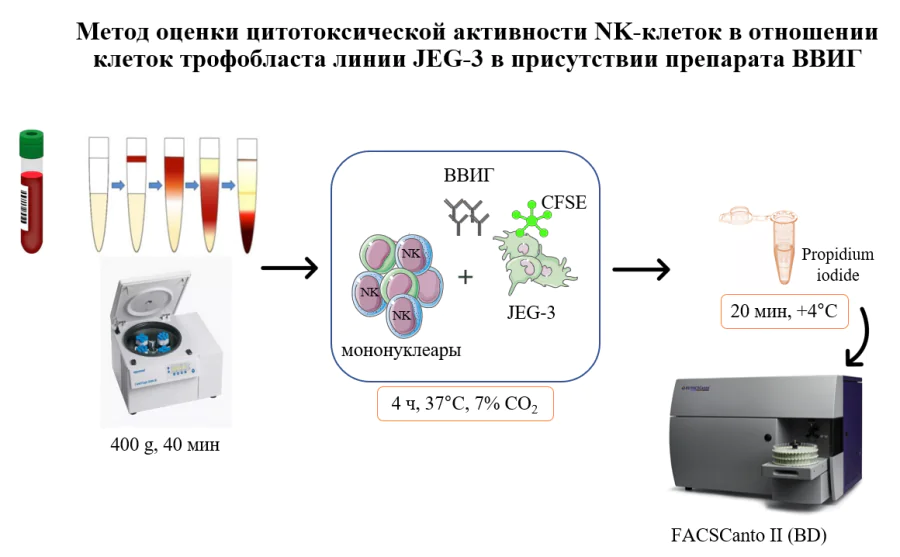
Intravenous immunoglobulins (IVIG) are one of the drugs used to overcome infertility and implantation failures. It has been shown that the use of the drug in preparation for IVF procedure increases the probability of successful implantation of a blastocyst, however, the exact mechanism of action of IVIG remains unclear. Its possible effect on the cytotoxic function of NK cells, which are capable of exhibiting cytotoxicity against fetal trophoblast cells, is suggested. We have developed a method for evaluating the cytoprotective effect of IVIG against trophoblast cells of the JEG-3 line in a model of their interaction with NK cells. We have shown that the death of trophoblast cells in the presence of peripheral blood NK cells of the mononuclear fraction and the IVIG preparation is reduced compared with samples without the addition of IVIG. The proposed model can be used at the stage of selecting therapy for various forms of reproductive pathology in which the use of IVIG is planned, including infertility (Patent No. 2768461).
The study of microvesicles of cellular origin as new subjects of intercellular signaling
+
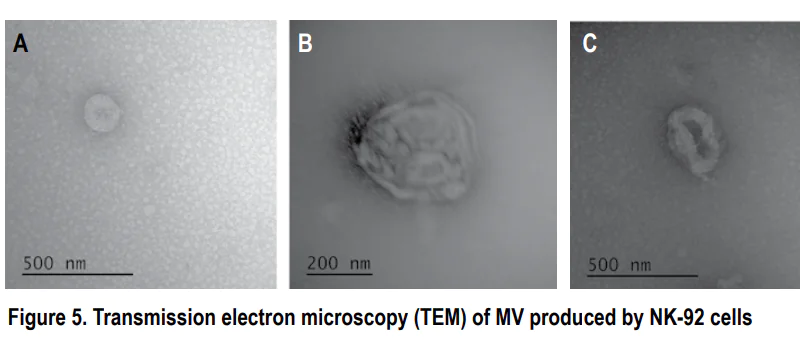
Microvesicles (MV) are produced by various cells and are the source of various protein and non-protein molecules. It is assumed that MV can mediate intercellular communication and modulate cell functions. An urgent issue is the ability of MV derived from NK cells to influence the functional state of endothelial cells (EC) in inflammatory processes. We studied the effect of MV obtained from NK-92 cells stimulated by IL-1β on the phenotype, caspase activity, proliferation and migration of EA.hy926 EC line. It was found that incubation of EC with MB obtained from NK-92 cells leads to a decrease in the proliferative activity of EC, the appearance of the panleukocyte marker CD45 on them, activation of caspase-3 and partial death of EC, as well as a decrease in CD105 expression. A more pronounced effect of MV obtained from stimulated NK-92 cells was found in reducing the migration activity of EC and the intensity of their expression of the CD54 molecule. Thus, the functional activity of MB is mediated by the conditions in which they are secreted, as well as their internal content. In addition, we evaluated the possibility of using MV as a diagnostic marker of external genital endometriosis (OGE). The phenotypic characteristics of MB of leukocyte origin in the peripheral blood of patients with NGE I-II were analyzed. In patients with NGE, compared with healthy women, the number of MB expressing CD14 and CD16 in plasma is increased. Analysis of the co-expression of leukocyte markers on MV revealed that in women with NGE, compared with healthy women, the number of MV with CD45+CD4+, CD3+CD4+ and CD3+CD8+ phenotypes was reduced and the number of MV with CD54+CD14+phenotype was increased Thus, the phenotypic characteristics of MV in women with NGE differ from those in healthy women, the data obtained can be used to develop methods for noninvasive diagnosis of NGE (Patent No. 2761539).
The study of angiogenesis and the effect of immune system cells on this process
+
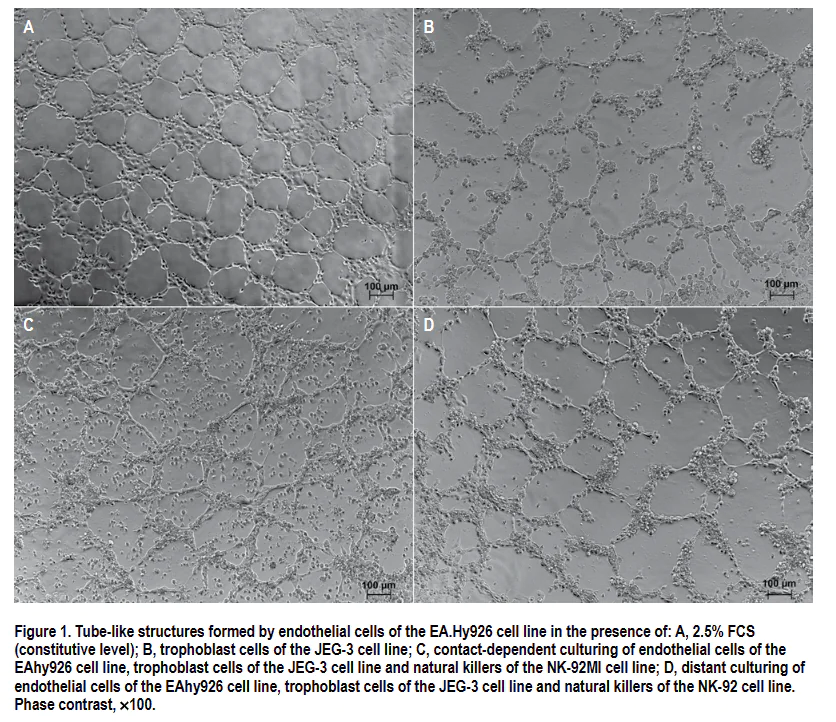
Regulation of angiogenesis in the uteroplacental bed determines adequate trophoblast invasion, formation and development of the placenta, as well as the successful course of pregnancy. The most significant influence on angiogenesis is exerted by natural killer (NK) cells, macrophages and trophoblast. We have created an in vitro model reflecting the interaction of NK cells, trophoblast and endothelium during angiogenesis in order to study the contact and distant effect of NK cells on the formation of tubular structures by co-culturing endothelial and trophoblast cells under the influence of various cytokines (bFGF, VEGF, PlGF, TGF-β, IL-8, IFNy and IL-1β). We have shown that the effect of cytokines on angiogenesis in a three-component coculture (NK cells, trophoblast cells and endothelial cells) differed from those previously identified in single-component (only endothelial cells) and two-component (coculture of endothelial cells and trophoblast cells) cell models. The results of these experiments showed that the regulation of placental cell interactions includes both cellular contacts and cytokine-mediated effects.
In addition, within the framework of this direction, work is underway to create a predictive model of angiogenesis based on artificial intelligence in cooperation with the V. P. Ivannikov Research Institute of System Programming of the Russian Academy of Sciences.
Studying the interaction of trophoblast cells and immune system cells
+
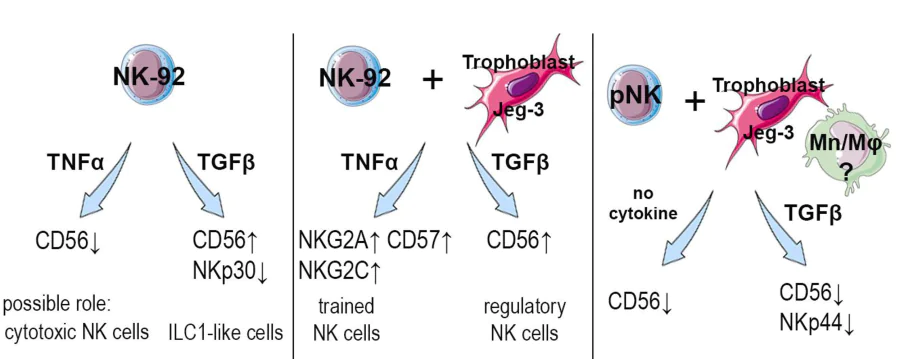
Cytokines secreted by cells of the decidual uterine membrane microenvironment can affect the phenotypic characteristics of NK cells and change their functional activity. An imbalance of pro- and anti-inflammatory signals can lead to the development of reproductive pathology. We evaluated the effect of a number of cytokines on NK cells of the NK-92 line and NK cells of peripheral blood in the presence of trophoblast cells of the JEG-3 line in an in vitro model. The effect of IFNy, TNFa, TGFß, IL-15, IL-18 on the expression of a number of activating and inhibitory receptors by NK cells was shown both in monoculture and during co-cultivation with trophoblast cells, as well as in the presence of conditioned placenta media of the 1st trimester of pregnancy. The results obtained indicate the modulation of NK cell function both by the cytokine microenvironment and directly by target cells.
Publications and patents
Found
Nothing found, try to update filter.
Валентина Анатольевна Михайлова, Алина Алексеевна Давыдова, Дмитрий Олегович Баженов, Валерия Алексеевна Загайнова, Игорь Юрьевич Коган, Олеся Николаевна Беспалова, Александр Мкртичевич Гзгзян, Дмитрий Игоревич Соколов, Сергей Алексеевич Сельков
RU2768461C1,
2022
Мария Игоревна Ярмолинская, Елена Игоревна Дурнева, Дмитрий Игоревич Соколов, Ксения Львовна Маркова, Сергей Алексеевич Сельков
RU2761539C1,
2021
Дмитрий Игоревич Соколов, Ксения Львовна Маркова, Сергей Алексеевич Сельков
RU2746950C1,
2021
2021
—
2023
| Сельков Сергей Алексеевич
2017
—
2019
| Сельков Сергей Алексеевич
Lab address
Россия, Санкт-Петербург, Менделеевская линия, 3Д
Authorization required.
